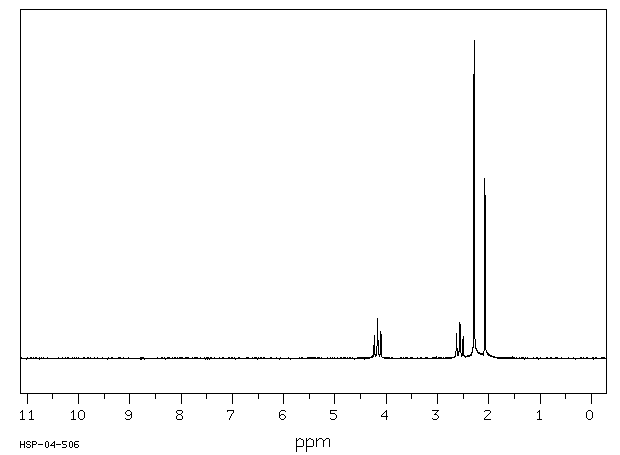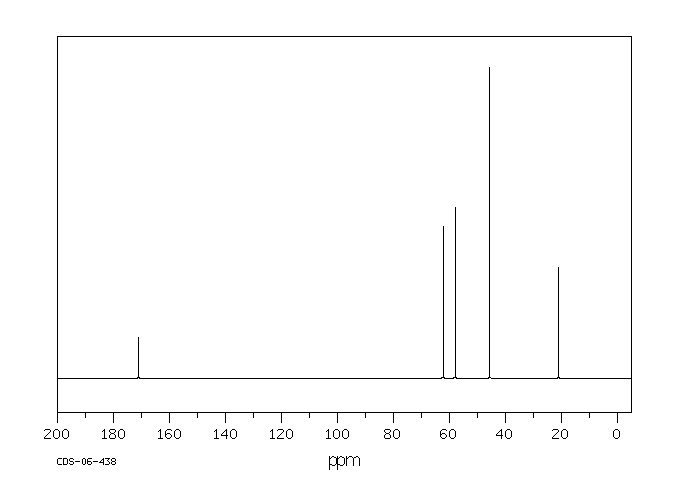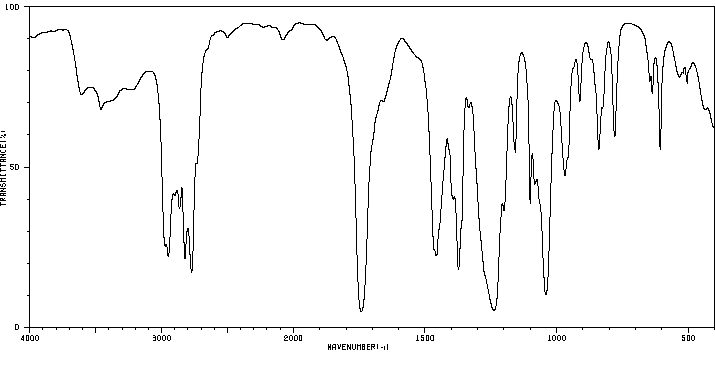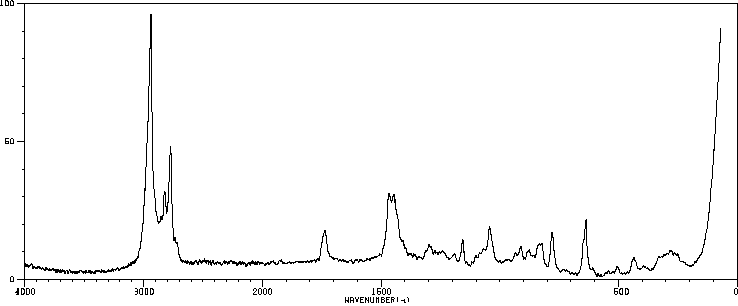2-二甲氨基乙基乙酸酯 | 1421-89-2
中文名称
2-二甲氨基乙基乙酸酯
中文别名
乙酸2-(二甲基氨基)乙酯;2-(二甲基氨基)乙基乙酸酯
英文名称
2-(Dimethylamino)ethyl acetate
英文别名
noracetylcholine
CAS
1421-89-2
化学式
C6H13NO2
mdl
MFCD00041912
分子量
131.175
InChiKey
GOLSFPMYASLXJC-UHFFFAOYSA-N
BEILSTEIN
——
EINECS
——
-
物化性质
-
计算性质
-
ADMET
-
安全信息
-
SDS
-
制备方法与用途
-
上下游信息
-
文献信息
-
表征谱图
-
同类化合物
-
相关功能分类
-
相关结构分类
物化性质
-
熔点:129-130 °C
-
沸点:152-154 °C
-
密度:0.92
-
闪点:47 °C
-
保留指数:1409
-
稳定性/保质期:
如果遵照规格使用和储存,则不会分解,未有已知危险反应。应避免与氧化物接触。
计算性质
-
辛醇/水分配系数(LogP):0.2
-
重原子数:9
-
可旋转键数:4
-
环数:0.0
-
sp3杂化的碳原子比例:0.833
-
拓扑面积:29.5
-
氢给体数:0
-
氢受体数:3
安全信息
-
危险等级:3
-
危险品标志:Xn
-
安全说明:S16,S26,S36/37/39
-
危险类别码:R21/22,R10,R36/37/38
-
RTECS号:AH2100000
-
海关编码:2922199090
-
包装等级:I; II; III
-
危险品运输编号:1993
-
储存条件:请将贮藏器保持密封,并存放在阴凉、干燥处。同时,确保工作环境有良好的通风或排气设施。
SDS
| Name: | 2-Dimethylaminoethyl Acetate Material Safety Data Sheet |
| Synonym: | Acetic Acid, 2-(Dimethylamino)Ethyl Ester; Dimethylaminoethanol Acetate |
| CAS: | 1421-89-2 |
Synonym:Acetic Acid, 2-(Dimethylamino)Ethyl Ester; Dimethylaminoethanol Acetate
Section 2 - COMPOSITION, INFORMATION ON INGREDIENTS
| CAS# | Chemical Name | content | EINECS# |
| 1421-89-2 | Acetic Acid, 2-(Dimethylamino)Ethyl Es | ca 100 | 215-827-4 |
Risk Phrases: 10
Section 3 - HAZARDS IDENTIFICATION
EMERGENCY OVERVIEW
Flammable.The toxicological properties of this material have not been fully investigated.
Potential Health Effects
Eye:
May cause eye irritation. May cause chemical conjunctivitis and corneal damage.
Skin:
May cause irritation and dermatitis. May cause cyanosis of the extremities.
Ingestion:
May cause gastrointestinal irritation with nausea, vomiting and diarrhea. The toxicological properties of this substance have not been fully investigated. Ingestion of large amounts may cause CNS depression.
Inhalation:
The toxicological properties of this substance have not been fully investigated. Aspiration may lead to pulmonary edema. Vapors may cause dizziness or suffocation. May cause burning sensation in the chest.
Chronic:
No information found.
Section 4 - FIRST AID MEASURES
Eyes: Flush eyes with plenty of water for at least 15 minutes, occasionally lifting the upper and lower eyelids. Get medical aid.
Skin:
Get medical aid. Flush skin with plenty of water for at least 15 minutes while removing contaminated clothing and shoes. Wash clothing before reuse.
Ingestion:
Get medical aid. Do NOT induce vomiting. If conscious and alert, rinse mouth and drink 2-4 cupfuls of milk or water.
Inhalation:
Remove from exposure and move to fresh air immediately. If not breathing, give artificial respiration. If breathing is difficult, give oxygen. Get medical aid.
Notes to Physician:
Section 5 - FIRE FIGHTING MEASURES
General Information:
As in any fire, wear a self-contained breathing apparatus in pressure-demand, MSHA/NIOSH (approved or equivalent), and full protective gear. Vapors may form an explosive mixture with air.
Vapors can travel to a source of ignition and flash back. During a fire, irritating and highly toxic gases may be generated by thermal decomposition or combustion. Will burn if involved in a fire. Use water spray to keep fire-exposed containers cool. Water may be ineffective. Material is lighter than water and a fire may be spread by the use of water. Containers may explode in the heat of a fire.
Flammable liquid and vapor. Vapors may be heavier than air. They can spread along the ground and collect in low or confined areas.
Extinguishing Media:
For small fires, use dry chemical, carbon dioxide, water spray or alcohol-resistant foam. For large fires, use water spray, fog, or alcohol-resistant foam. Use water spray to cool fire-exposed containers. Water may be ineffective. Do NOT use straight streams of water.
Section 6 - ACCIDENTAL RELEASE MEASURES
General Information: Use proper personal protective equipment as indicated in Section 8.
Spills/Leaks:
Absorb spill with inert material (e.g. vermiculite, sand or earth), then place in suitable container. Clean up spills immediately, observing precautions in the Protective Equipment section. Remove all sources of ignition. Use a spark-proof tool. Provide ventilation. A vapor suppressing foam may be used to reduce vapors.
Section 7 - HANDLING and STORAGE
Handling:
Wash thoroughly after handling. Remove contaminated clothing and wash before reuse. Use with adequate ventilation. Ground and bond containers when transferring material. Use spark-proof tools and explosion proof equipment. Avoid contact with eyes, skin, and clothing. Empty containers retain product residue, (liquid and/or vapor), and can be dangerous. Keep container tightly closed. Keep away from heat, sparks and flame. Avoid ingestion and inhalation. Do not pressurize, cut, weld, braze, solder, drill, grind, or expose empty containers to heat, sparks or open flames.
Storage:
Keep away from heat, sparks, and flame. Keep away from sources of ignition. Store in a tightly closed container. Store in a cool, dry, well-ventilated area away from incompatible substances.
Flammables-area.
Section 8 - EXPOSURE CONTROLS, PERSONAL PROTECTION
Engineering Controls:
Facilities storing or utilizing this material should be equipped with an eyewash facility and a safety shower. Use adequate general or local explosion-proof ventilation to keep airborne levels to acceptable levels.
Exposure Limits CAS# 1421-89-2: Personal Protective Equipment Eyes: Wear appropriate protective eyeglasses or chemical safety goggles as described by OSHA's eye and face protection regulations in 29 CFR 1910.133 or European Standard EN166.
Skin:
Wear appropriate protective gloves to prevent skin exposure.
Clothing:
Wear appropriate protective clothing to prevent skin exposure.
Respirators:
A respiratory protection program that meets OSHA's 29 CFR 1910.134 and ANSI Z88.2 requirements or European Standard EN 149 must be followed whenever workplace conditions warrant respirator use.
Section 9 - PHYSICAL AND CHEMICAL PROPERTIES
Physical State: Liquid
Color: colorless
Odor: Not available.
pH: Not available.
Vapor Pressure: Not available.
Viscosity: Not available.
Boiling Point: 152.0 - 154.0 deg C
Freezing/Melting Point: Not available.
Autoignition Temperature: Not available.
Flash Point: 47 deg C ( 116.60 deg F)
Explosion Limits, lower: Not available.
Explosion Limits, upper: Not available.
Decomposition Temperature:
Solubility in water:
Specific Gravity/Density: .9280g/cm3
Molecular Formula: C6H13NO2
Molecular Weight: 131.17
Section 10 - STABILITY AND REACTIVITY
Chemical Stability:
Stable under normal temperatures and pressures.
Conditions to Avoid:
Incompatible materials, ignition sources, excess heat, strong oxidants.
Incompatibilities with Other Materials:
Oxidizing agents.
Hazardous Decomposition Products:
Carbon monoxide, oxides of nitrogen, irritating and toxic fumes and gases, carbon dioxide.
Hazardous Polymerization: Has not been reported
Section 11 - TOXICOLOGICAL INFORMATION
RTECS#:
CAS# 1421-89-2: AH2100000 LD50/LC50:
Not available.
Carcinogenicity:
Acetic Acid, 2-(Dimethylamino)Ethyl Ester - Not listed by ACGIH, IARC, or NTP.
Other:
See actual entry in RTECS for complete information.
Section 12 - ECOLOGICAL INFORMATION
Section 13 - DISPOSAL CONSIDERATIONS
Dispose of in a manner consistent with federal, state, and local regulations.
Section 14 - TRANSPORT INFORMATION
IATA
Shipping Name: FLAMMABLE LIQUID, N.O.S.*
Hazard Class: 3
UN Number: 1993
Packing Group: III
IMO
Shipping Name: FLAMMABLE LIQUID, N.O.S.
Hazard Class: 3.3
UN Number: 1993
Packing Group: III
RID/ADR
Shipping Name: FLAMMABLE LIQUID, N.O.S.
Hazard Class: 3
UN Number: 1993
Packing group: III
Section 15 - REGULATORY INFORMATION
European/International Regulations
European Labeling in Accordance with EC Directives
Hazard Symbols: Not available.
Risk Phrases:
R 10 Flammable.
Safety Phrases:
S 9 Keep container in a well-ventilated place.
S 16 Keep away from sources of ignition - No
smoking.
S 28A After contact with skin, wash immediately with
plenty of water.
S 33 Take precautionary measures against static
discharges.
S 37 Wear suitable gloves.
S 45 In case of accident or if you feel unwell, seek
medical advice immediately (show the label where
possible).
WGK (Water Danger/Protection)
CAS# 1421-89-2: No information available.
Canada
CAS# 1421-89-2 is listed on Canada's DSL List.
CAS# 1421-89-2 is not listed on Canada's Ingredient Disclosure List.
US FEDERAL
TSCA
CAS# 1421-89-2 is listed on the TSCA inventory.
SECTION 16 - ADDITIONAL INFORMATION
N/A
上下游信息
-
下游产品
中文名称 英文名称 CAS号 化学式 分子量 —— 2-(dimethylamino)ethyl acetate N-oxide 29456-73-3 C6H13NO3 147.174
反应信息
-
作为反应物:描述:参考文献:名称:PYROLYSIS OF DIMETHYLETHANOLAMINE OXIDE MONOHYDRATE摘要:不可用DOI:10.1139/v66-242
-
作为产物:描述:参考文献:名称:Dimethylamino derivatives and their use摘要:二甲氨基烷基)羧酸酯和-氨基甲酸酯以及(二甲氨基烷基)醚和脲是一种特别适用于作为聚环氧化合物的胺固化剂的化合物。它们赋予可固化混合物更长的固化时间,从而具有良好的加工性能,尤其是当这些混合物用作胶粘剂时。此外,机械性能通常也会得到改善。此外,由于这些化合物的挥发性低,因此在作为固化剂时具有优势。公开号:US04324739A1
-
作为试剂:参考文献:名称:硝基杂环还原是分子向药物输送至低氧细胞的分子内催化的范例。摘要:DOI:10.1021/jm00113a040
文献信息
-
[EN] LIPIDS AND LIPID COMPOSITIONS FOR THE DELIVERY OF ACTIVE AGENTS<br/>[FR] LIPIDES ET COMPOSITIONS LIPIDIQUES POUR L'ADMINISTRATION DE PRINCIPES ACTIFS申请人:NOVARTIS AG公开号:WO2014136086A1公开(公告)日:2014-09-12This invention provides for a compound of formula (I): or a pharmaceutically acceptable salt thereof, wherein R1–R4, L and X are defined herein. The compounds of formula (I) and pharmaceutically acceptable salts thereof are cationic lipids useful in the delivery of biologically active agents to cells and tissues.这项发明提供了一个式(I)的化合物,或其药用可接受的盐,其中R1-R4、L和X在此处被定义。式(I)的化合物及其药用可接受的盐是在将生物活性剂传递给细胞和组织中时有用的阳离子脂质。
-
[EN] ALKYNE COMPOUNDS AS S-NITROSOGLUTATHIONE REDUCTASE INHIBITORS<br/>[FR] COMPOSÉS DE TYPE ALCYNE EN TANT QU'INHIBITEURS DE LA S-NITROSOGLUTATHIONE RÉDUCTASE申请人:GLENMARK PHARMACEUTICALS SA公开号:WO2016055947A1公开(公告)日:2016-04-14Provided are compounds of formula (Ia) and pharmaceutically acceptable salts thereof, wherein A, B, R 1, R 2, m and n are as defined herein, which are active as inhibitors of S-Nitrosoglutathione reductase (GSNOR). These compounds prevent, inhibit, or suppress the action of GSNOR and are therefore useful in the treatment of GSNOR mediated diseases, disorders, syndromes or conditions such as, e.g., pulmonary hypertension, acute respiratory distress syndrome (ARDS), asthma, bronchospasm, cough, pneumonia, pulmonary fibrosis, interstitial lung diseases, cystic fibrosis and chronic obstructive pulmonary disease (COPD).
-
QUINAZOLINES USEFUL AS MODULATORS OF VOLTAGE GATED ION CHANNELS申请人:Wilson Dean公开号:US20080167305A1公开(公告)日:2008-07-10The present invention relates to compounds useful as inhibitors of voltage-gated sodium channels. The invention also provides pharmaceutically acceptable compositions comprising the compounds of the invention and methods of using the compositions in the treatment of various disorders.
-
CONFORMATIONALLY CONSTRAINED, FULLY SYNTHETIC MACROCYCLIC COMPOUNDS申请人:POLYPHOR AG公开号:US20150051183A1公开(公告)日:2015-02-19The conformationally restricted, spatially defined macrocyclic ring system of formula (I) is constituted by three distinct molecular parts: Template A, conformation Modulator B and Bridge C. Macrocycles described by this ring system I are readily manufactured by parallel synthesis or combinatorial chemistry in solution or on solid phase. They are designed to interact with a variety of specific biological target classes, examples being agonistic or antagonistic activity on G-protein coupled receptors (GPCRs), inhibitory activity on enzymes or antimicrobial activity. In particular, these macrocycles show inhibitory activity on endothelin converting enzyme of subtype 1 (ECE-1) and/or the cysteine protease cathepsin S (CatS), and/or act as antagonists of the oxytocin (OT) receptor, thyrotropin-releasing hormone (TRH) receptor and/or leukotriene B4 (LTB4) receptor, and/or as agonists of the bombesin 3 (BB3) receptor, and/or show antimicrobial activity against at least one bacterial strain. Thus they are showing great potential as medicaments for a variety of diseases.公式(I)的构象受限、空间定义的大环环系统由三个不同的分子部分组成:模板A、构象调节剂B和桥C。由这种环系统I描述的大环可通过并行合成或溶液中或固相上的组合化学轻松制造。它们被设计用于与各种特定生物靶标类相互作用,例如在G蛋白偶联受体(GPCR)上的激动或拮抗活性,酶的抑制活性或抗菌活性。特别是,这些大环显示对亚型1的内皮素转化酶(ECE-1)和/或半胱氨酸蛋白酶卡特普辛S(CatS)的抑制活性,和/或作为催产素(OT)受体、促甲状腺释放激素(TRH)受体和/或白三烯B4(LTB4)受体的拮抗剂,和/或作为瘤胃素3(BB3)受体的激动剂,和/或对至少一种细菌菌株显示抗菌活性。因此,它们显示出作为各种疾病药物的巨大潜力。
-
Hydrogen-Bond Interactions of Nicotine and Acetylcholine Salts: A Combined Crystallographic, Spectroscopic, Thermodynamic and Theoretical Study作者:Virginie Arnaud、Michel Berthelot、Michel Evain、Jérôme Graton、Jean-Yves Le QuestelDOI:10.1002/chem.200600808日期:2007.2.2experimental HB basicity of the cations despite its potential multisite HB acceptor properties. The preferred HB interaction site of the ammonium picrate salts was determined from a survey of crystallographic data found in the Cambridge Structural Database (CSD) and is supported by theoretical calculations. Two distinct classes of ammonium groups were characterised depending on the absence (quaternary ammonium)尼古丁和乙酰胆碱(ACh)的单电荷活性形式的氢键(HB)相互作用已通过使用密度泛函理论(DFT)计算从理论上进行了比较,并在晶体学观察和溶液中平衡常数的测量基础上进行了实验比较。尽管有潜在的多位HB受体特性,但使用2,4,6-三硝基苯酚(苦味酸)抗衡离子确定阳离子的实验HB碱性。根据在剑桥结构数据库(CSD)中发现的晶体学数据确定了优选的苦味酸铵HB相互作用位点,并得到了理论计算的支持。根据是否存在(季铵)或存在(三级,连接两个离子的N(+)HO氢键形成仲和伯铵盐)确定了烟酸烟碱的晶体结构,并将其与ACh进行了比较。该分析揭示了烟碱乙酰胆碱受体(nAChR)配体的铵部分对苦味酸根阴离子的特殊行为。已经开发出专用方法来分离阴离子和阳离子接受位点对溶液中测量的离子对的整体HB碱度的贡献。通过使用几种带有非碱性铵阳离子的模型离子对,在二氯甲烷溶液中测定了与两种不同铵类相关的苦味酸根阴离子的HB碱
表征谱图
-
氢谱1HNMR
-
质谱MS
-
碳谱13CNMR
-
红外IR
-
拉曼Raman
-
峰位数据
-
峰位匹配
-
表征信息
同类化合物
(甲基3-(二甲基氨基)-2-苯基-2H-azirene-2-羧酸乙酯)
(±)-盐酸氯吡格雷
(±)-丙酰肉碱氯化物
(d(CH2)51,Tyr(Me)2,Arg8)-血管加压素
(S)-(+)-α-氨基-4-羧基-2-甲基苯乙酸
(S)-阿拉考特盐酸盐
(S)-赖诺普利-d5钠
(S)-2-氨基-5-氧代己酸,氢溴酸盐
(S)-2-[[[(1R,2R)-2-[[[3,5-双(叔丁基)-2-羟基苯基]亚甲基]氨基]环己基]硫脲基]-N-苄基-N,3,3-三甲基丁酰胺
(S)-2-[3-[(1R,2R)-2-(二丙基氨基)环己基]硫脲基]-N-异丙基-3,3-二甲基丁酰胺
(S)-1-(4-氨基氧基乙酰胺基苄基)乙二胺四乙酸
(S)-1-[N-[3-苯基-1-[(苯基甲氧基)羰基]丙基]-L-丙氨酰基]-L-脯氨酸
(R)-乙基N-甲酰基-N-(1-苯乙基)甘氨酸
(R)-丙酰肉碱-d3氯化物
(R)-4-N-Cbz-哌嗪-2-甲酸甲酯
(R)-3-氨基-2-苄基丙酸盐酸盐
(R)-1-(3-溴-2-甲基-1-氧丙基)-L-脯氨酸
(N-[(苄氧基)羰基]丙氨酰-N〜5〜-(diaminomethylidene)鸟氨酸)
(6-氯-2-吲哚基甲基)乙酰氨基丙二酸二乙酯
(4R)-N-亚硝基噻唑烷-4-羧酸
(3R)-1-噻-4-氮杂螺[4.4]壬烷-3-羧酸
(3-硝基-1H-1,2,4-三唑-1-基)乙酸乙酯
(2S,4R)-Boc-4-环己基-吡咯烷-2-羧酸
(2S,3S,5S)-2-氨基-3-羟基-1,6-二苯己烷-5-N-氨基甲酰基-L-缬氨酸
(2S,3S)-3-((S)-1-((1-(4-氟苯基)-1H-1,2,3-三唑-4-基)-甲基氨基)-1-氧-3-(噻唑-4-基)丙-2-基氨基甲酰基)-环氧乙烷-2-羧酸
(2S)-2,6-二氨基-N-[4-(5-氟-1,3-苯并噻唑-2-基)-2-甲基苯基]己酰胺二盐酸盐
(2S)-2-氨基-N,3,3-三甲基-N-(苯甲基)丁酰胺
(2S)-2-氨基-3-甲基-N-2-吡啶基丁酰胺
(2S)-2-氨基-3,3-二甲基-N-(苯基甲基)丁酰胺,
(2S)-2-氨基-3,3-二甲基-N-2-吡啶基丁酰胺
(2S,4R)-1-((S)-2-氨基-3,3-二甲基丁酰基)-4-羟基-N-(4-(4-甲基噻唑-5-基)苄基)吡咯烷-2-甲酰胺盐酸盐
(2R,3'S)苯那普利叔丁基酯d5
(2R)-2-氨基-3,3-二甲基-N-(苯甲基)丁酰胺
(2-氯丙烯基)草酰氯
(1S,3S,5S)-2-Boc-2-氮杂双环[3.1.0]己烷-3-羧酸
(1R,5R,6R)-5-(1-乙基丙氧基)-7-氧杂双环[4.1.0]庚-3-烯-3-羧酸乙基酯
(1R,4R,5S,6R)-4-氨基-2-氧杂双环[3.1.0]己烷-4,6-二羧酸
齐特巴坦
齐德巴坦钠盐
齐墩果-12-烯-28-酸,2,3-二羟基-,苯基甲基酯,(2a,3a)-
齐墩果-12-烯-28-酸,2,3-二羟基-,羧基甲基酯,(2a,3b)-(9CI)
黄酮-8-乙酸二甲氨基乙基酯
黄荧菌素
黄体生成激素释放激素(1-6)
黄体生成激素释放激素 (1-5) 酰肼
黄体瑞林
麦醇溶蛋白
麦角硫因
麦芽聚糖六乙酸酯
麦根酸











